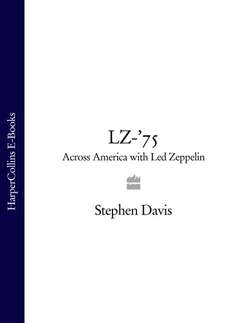Читать книгу LZ-’75: Across America with Led Zeppelin - Stephen Davis - Страница 11
CHAPTER 7 A Complex Die-Cut Affair
ОглавлениеTaking my assignment seriously, I had to familiarize myself with Led Zeppelin’s music. (A friend pointed out that I was a Stones fan, a reggae nut, and a student of Moroccan music. She challenged me on various points of Zeppelin lore—like who gave the band its name. I didn’t know. She told me it was Keith Moon.) So I started listening to the Zeppelin albums, in order. First was the Yardbirds’ last album from 1967, Little Games, on which Jimmy Page had played. Then Jeff Beck’s 1968 Truth, which featured Jimmy, John Bonham, and John Paul Jones on several tracks. Then Danny Goldberg sent me the entire Zeppelin catalogue on vinyl. I knew—indeed had worn out—Led Zeppelin. I couldn’t believe what a great rock & roll record Led Zeppelin II was—“with a purple umber-ella and a fifty cent hat.” Led Zeppelin III from 1970 was an obvious homage to the important California musicians of the day—David Crosby, Stephen Stills, Neil Young, and especially Joni Mitchell. The untitled 1971 fourth album, the sleeve depicting the old man burdened by the bundle of sticks, had “Stairway to Heaven,” which I’d heard too much on the radio but could easily understand why it had become such a teenage anthem. (In America, when a kid died in a car crash, his friends would call the local radio station and ask them to play “Stairway” to coincide with the funeral.) I had never even listened to 1973’s Houses of the Holy, but I loved the lurid, burnt-orange jacket, the naked children climbing the Giant’s Causeway, and the frankly pagan vibe of the music, not to mention such hard-rock masterpieces as “The Ocean” and “Over the Hills and Far Away.”
My brother Chris Davis is eight years younger than I. In 1975 he was still in the clutches of ardent Zeppelin fandom. He told me I had to hear the Led Zeppelin bootleg records because the mystical connection between the band and “the kids” was about a communion forged by their intense live shows, which could get very electrical and Dionysian. Chris made sure I got the right bootlegs: Live on Blueberry Hill (L.A. Forum 1970); In the Light (1969 BBC radio broadcasts); Unburied Dead Zeppo’s Grave (Japan 1971); Going to California with Led Zeppelin (L.A. Forum 1972); and Bonzo’s Birthday Party (L.A. Forum 1973).
Chris was right. Despite uneven sound quality, the bootlegged concert recordings told more of the story. I could hear the kids yelling stuff at the band, and cheering at the start and end of favorite songs. I could hear Robert Plant talking to the audiences between songs, saying very funny things, and adlibbing lyrics to the older warhorses. It was now easier for me to appreciate the unusual, semimystical bond between this band and its very large fan base.
Now I began to wonder about the forthcoming, rabidly anticipated new Led Zeppelin album, Physical Graffiti. Where was it? It was already mid-January 1975, and the band was about to go on the most lucrative tour of its career. Usually, a rock band would release an album and a 45-rpm single for radio airplay, and then rely on the ensuing tour to draw publicity for the album to pump up sales figures. But Led Zeppelin had a contrarian attitude toward the record industry. Jimmy Page refused to release singles because he didn’t like editing and remixing his recordings to sound good on a tinny American car radio. I was fascinated that Led Zeppelin didn’t seem to mind going on the road with no new product to sell—on its own new label, no less.
There were good reasons for the album delay. Jimmy had postponed signing off on the final mixes the previous November because they were waiting for some Indian musicians to add some backing tracks to the anthemic new song, “Kashmir.” (The musicians never showed up.) The jacket for the double album (two LPs) was a complex, die-cut affair with sliding panels and open windows that took a long time to get right. And with fifteen new songs, Jimmy Page’s famous perfectionism guaranteed that Physical Graffiti could never have arrived on schedule.
The band shrugged, and went on tour anyway.
On Saturday night, January 11, Led Zeppelin played an unannounced show at the Ahoy, a rock club in the port city of Rotterdam, Holland. This was the first time an audience had heard some of the band’s new songs, and if the delivery was sometimes a little ragged, the reception veered between respectful and rapturous. Robert was so nervous after his eighteen-month layoff that he forgot the words to “Stairway to Heaven.” Fortunately, the audience knew the lyric and sang it for him.
The consensus in the dressing room was that they had tried to play too many songs the first night.
But it was a shambles the next night in Brussels, Belgium, at the Vorst Nationaal arena. The band was using these shows as open rehearsals, playing without the new light show, again experimenting on the concert versions of “Trampled Under Foot,” “Kashmir,” and other new songs. They tried out an arrangement of “When the Levee Breaks,” which they’d never tried to play in concert before.
But nobody felt well. John Bonham was shaky, very hung-over from the night before, and failed to play “Moby Dick,” his cannonade of a drum solo. Jimmy Page looked sick, so “Dazed and Confused” was also left out of the set. After less than two hours, Led Zeppelin walked off the stage to sustained applause and demands for an encore, which they didn’t play. Jimmy Page murmured to Peter Grant that this band was going to have to pull itself together if they didn’t want to get bottled off the stage in America, in just two short weeks.
